Kielce 2023-09-25
Kielce Główny railway station.
Geographic coordinates: 50.874 N 20.618 E. Elevation 264 m.
Kielce Główny railway station.
Kielce Główny railway station is the most important station in Kielce. For many years it was called Kielce, but after a period of stagnation in the development of railways in Poland, it developed and many new railway stations and stops were built. Therefore, to avoid any doubts as to which station it is, the councilors in Kielce unanimously changed the name to Kielce Główny. A similar thing happened in Radom, where the most important station was named Radom Główny.
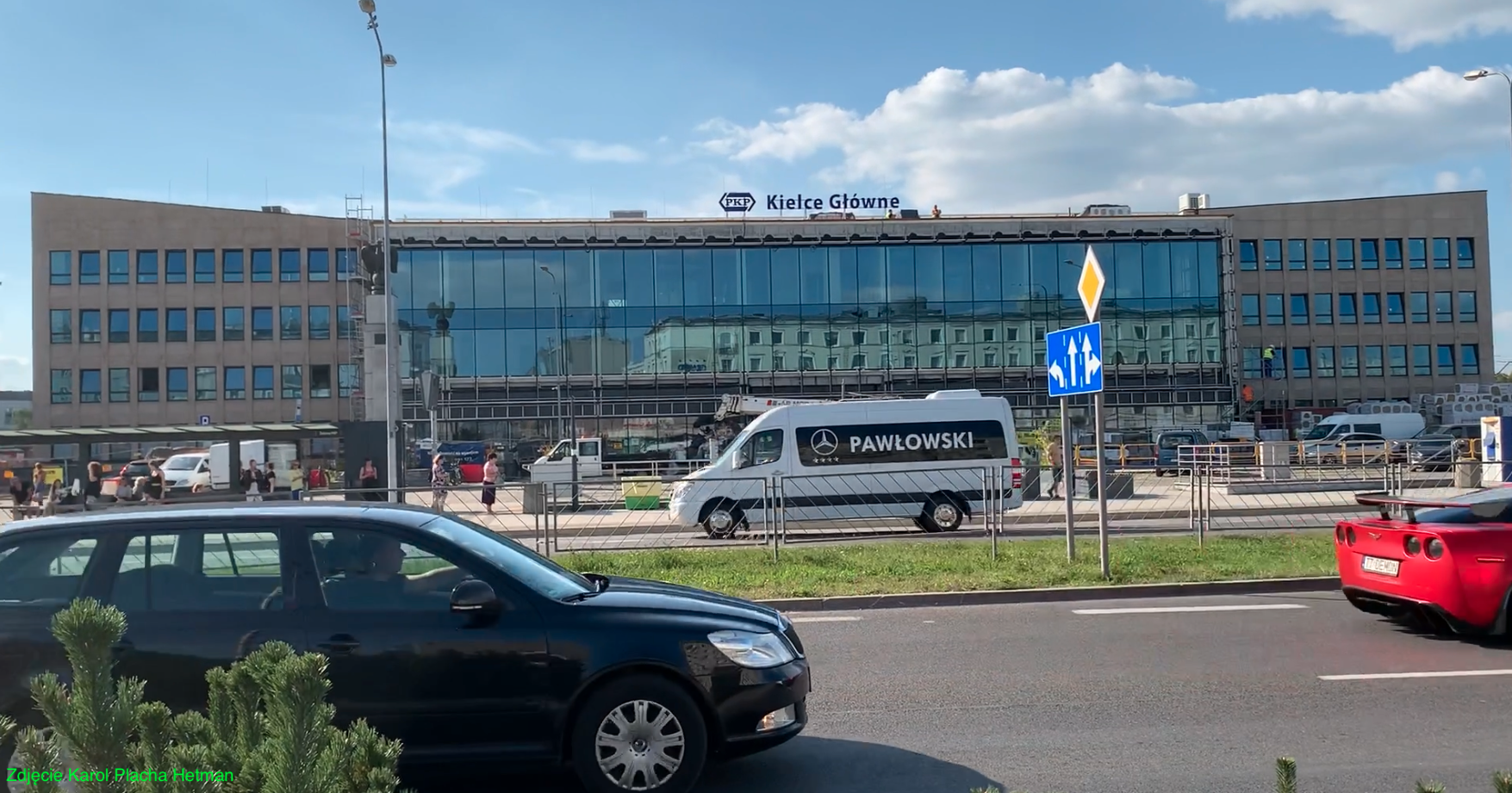
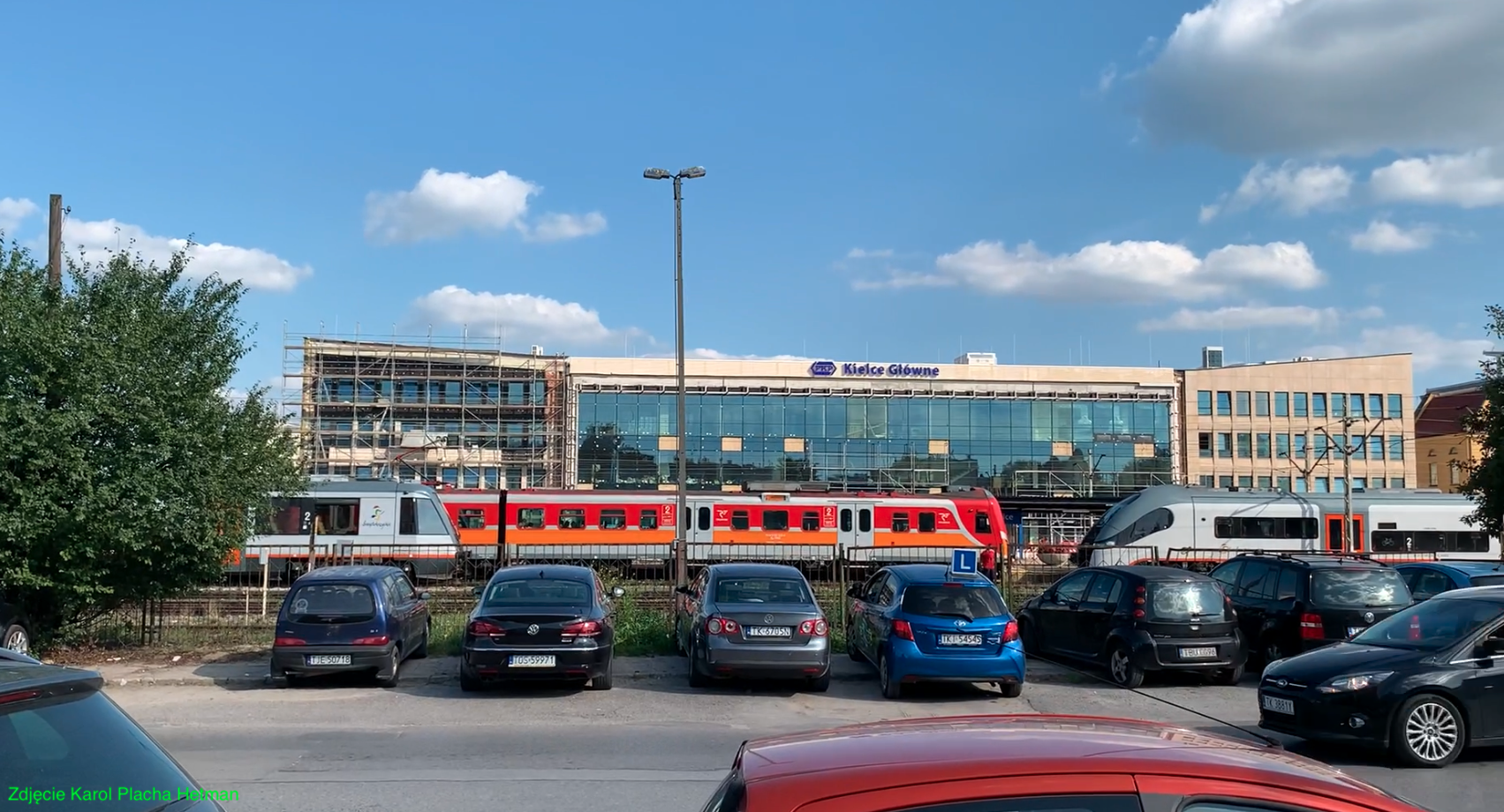
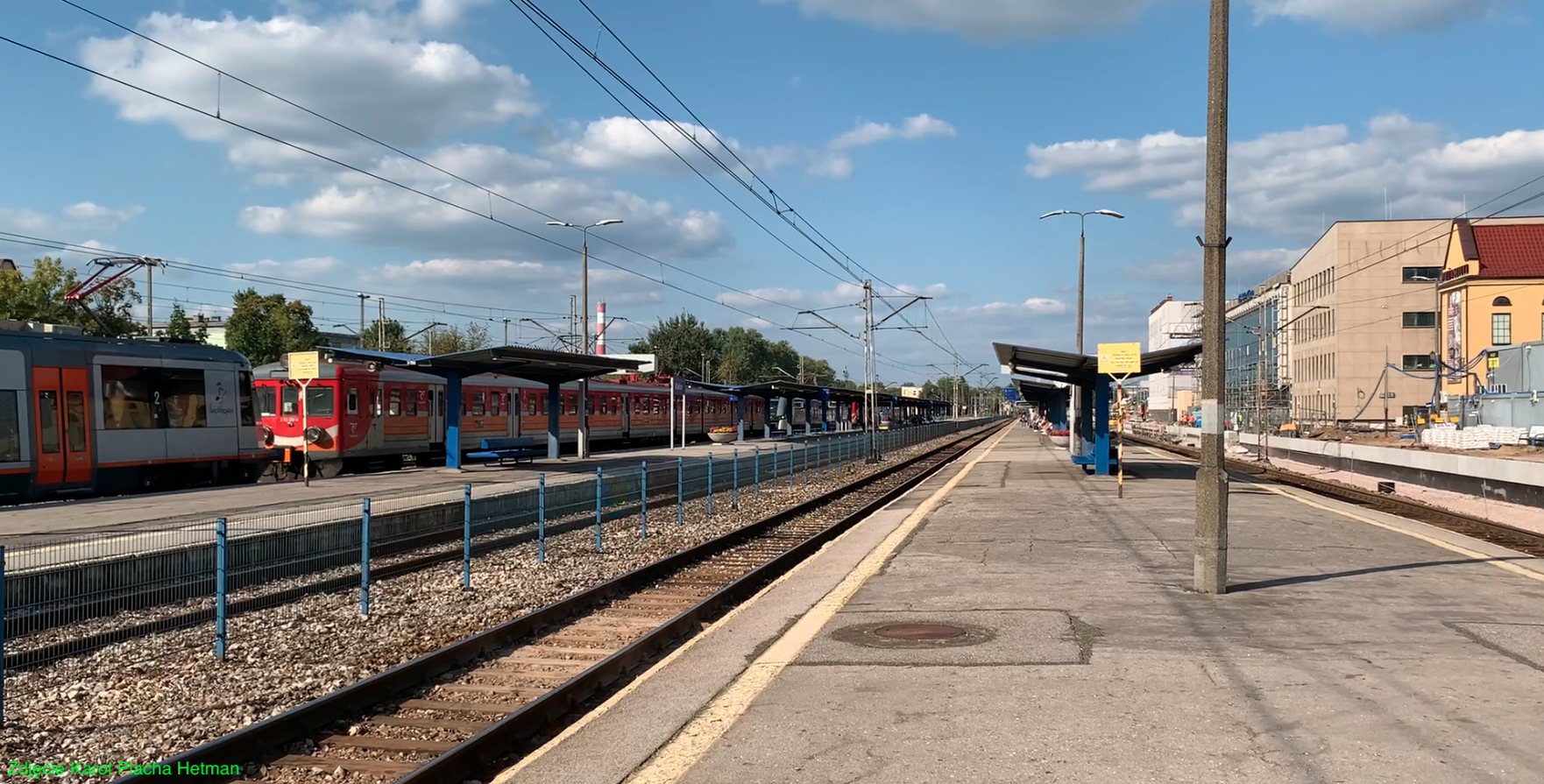
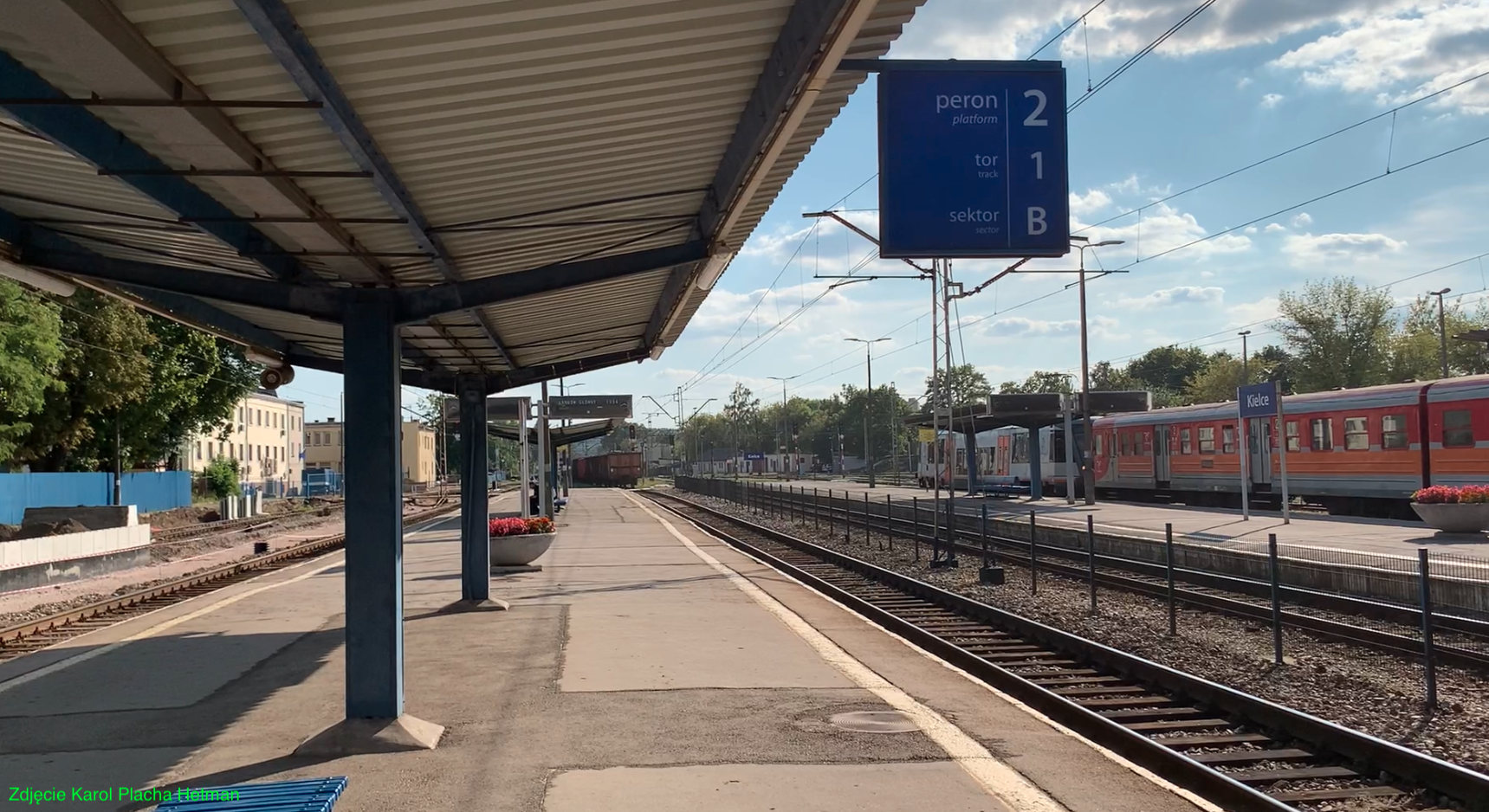
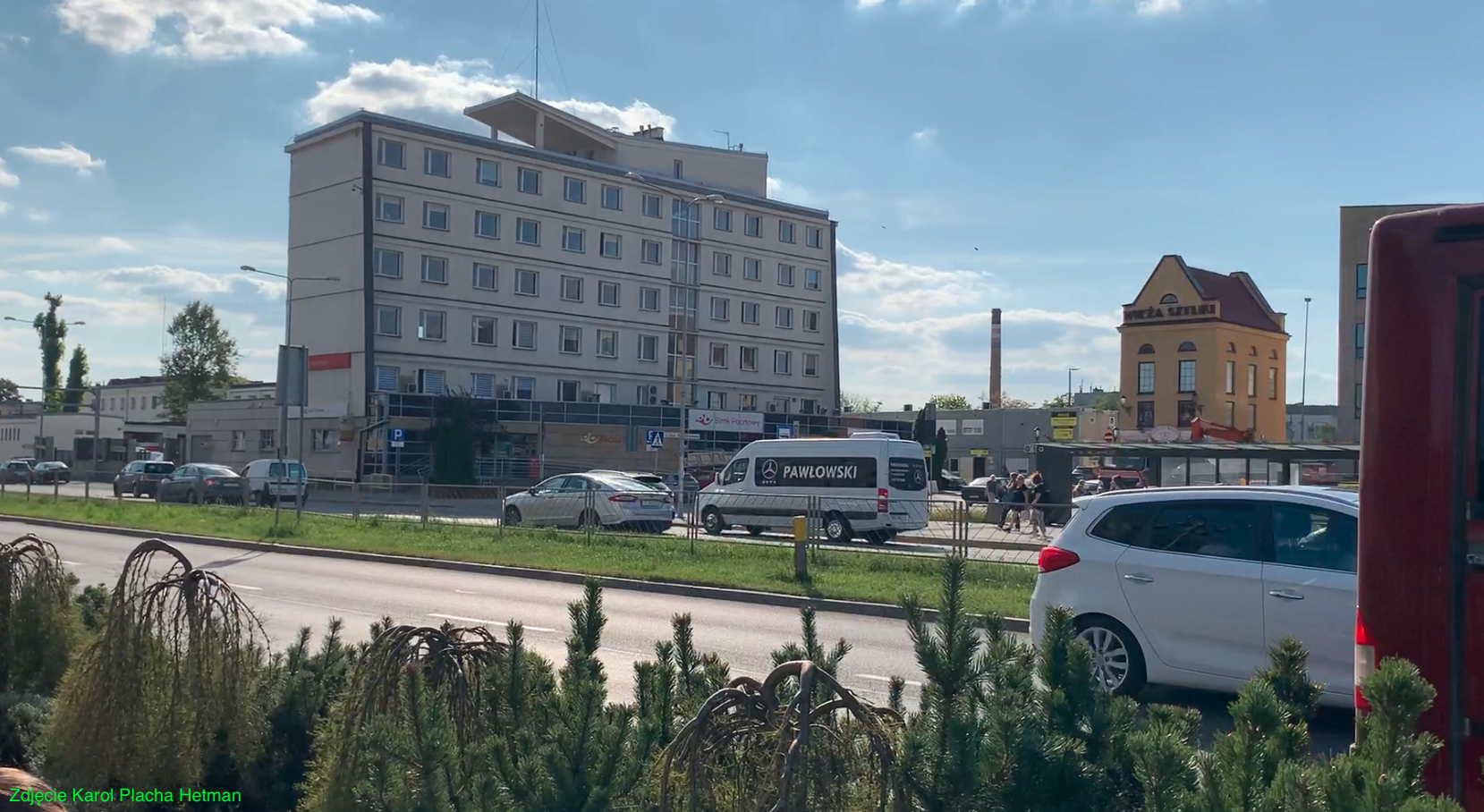
Iwanogrodzko-Dąbrowska Iron Road.
The Muscovites allowed the construction of a railway line, which was named the Iwanogrodzko-Dąbrowska Railway. The line connected Iwangorodzko, Polish name Dęblin, with the town of Dąbrowa, Polish name Dąbrowa Górnicza. Dąbrowa Górnicza is Zagłębie Dąbrowskie, Dęblin is Zagłębie Staropolskie. The name Ivangorod came from the name of the bandit, governor of the Kingdom of Poland, Ivan Paskevich. The line was 461.9 km long and had a wide rail gauge; 1524mm. Construction of the trail began in 1882. 18,000 - 20,000 workers were employed. Construction works lasted in the period 1882-1885. Already in 1919, the Poles converted the track into a normal one. The line ran through Radom, Skarżysko-Kamienna (Bzin ruskie Бзин, 1885–1897), Kielce, Olkusz to Dąbrowa Górnicza. Additionally, there were branches to Sosnowiec and the Granica station. Important were the branches from the Bzin station to the Koluszki station in a north-western direction (1885-1886) and to the Ostrowiec station in an eastern direction (1885-1886).
In 1880, the lack of even a single railway line in the Kielce region was already clearly visible. It was a brake on development. Transport by horse-drawn carriages was inefficient. Many manufactories and factories already had steam engines that needed hard coal. And the manufactured products could be exported to the East.
Demands were also put forward by the inhabitants of Sandomierz, who wanted a convenient connection with Piotrków (now Piotrków Trybunalski). At that time, Piotrków was the capital of the governorate. In 1862, another initiative was blocked due to the outbreak of the January Uprising. Then there was an initiative by a group of bankers to build a trail; Ostrowiec - Szydłowiec - Radom. And this initiative did not receive a license. There was also another initiative to build a trail; Piotrków - Końskie - Skarżysko - Starachowice - Ostrowiec - Opatów. Another concept was to direct the railway to the trail; Opatów - Stopnica - Kazimierza Wielka - Dąbrowa Tarnowska - Tarnów. There was also the concept of a trail; Iwanogród - Kraków, with branches to Dąbrowa and Koluszki.
Unexpectedly, in April 1875, in St. Petersburg, it was decided to build the Iwanogród - Dąbrowa Górnicza line, as well as branches to Koluszki and Ostrowiec. The Ministry of War stipulated that the rail gauge should be 1,524 mm. There should be two tunnels on the trail, which should be easily destroyed in the event of war to block transport, hence the name of the current Charsznica railway station and the second Tunnel station.
16 companies took part in the tender. Because the Muscovites delayed the competition, most interested entities withdrew from the planned competition. The Warsaw-Vienna Railway Company tried unsuccessfully to obtain concessions, and in 1912 it was finally liquidated by order of the tsar. The Warsaw-Vienna Railway Company offered to build the route, 1 million rubles cheaper than its competitor Bloch, the Ivangorod-Dąbrowa Railway Company. Jan Giotlib (Gotlib) Bloch was a Polish banker born in Radom. He was later called the "King of Polish Railways".
Ultimately, only one company led by a banker took part in the tender; Bloch Railway Company Iwangrodzko-Dąbrowa. It was a typically pro-Moscow company with no experience in the construction and operation of railway lines. For the company, building wide tracks was never in question. In May 1876, the company received a preliminary license. On July 10, 1881, Tsar Alexander III approved the concession and the route of the route. The trail was to be 461.9 km long and it was the longest line in the Kingdom of Poland and the entire Muscovite State. The route ran through the following towns: Dęblin - Radom - Bzin - Kielce - Olkusz - Sławków - Strzemieszyce - Dąbrowa. It had branches from Bzino (Skarżyska-Kamienna) through Końskie and Opoczno to Koluszki and in the opposite direction to Ostrowiec and Bodzechów, as well as from Strzemieszyce through Kazimierz to the town of Maczki.
On December 21, 1883, the first section from Dęblin (next to the Dęblin Fortress), through the bridge over the Vistula, and then Radom - Skarżyska Kamienna - Kielce was put into operation. On January 26, 1885, the Kielce - Dąbrowa section was opened. The wide track ended at Huta Bankowa in Dąbrowa Górnicza. In the town of Granica (Maczki), a broad-gauge station was built in close proximity to the standard-gauge Granica station. The trail was officially launched in 1885. The line's management was located in Radom. Already in 1919, all wide tracks were converted to standard gauge.
The Ivangorod-Dąbrowska Railway was 433 versts long. 1 verst was 500 fathoms, and that was 1.0668 km. The road was divided into three sections: First section; Ivangorod - Bzinsky, from Ivangorod to Bzin (91 versts). Second branch; Bzińsko – Dąbrowski, from Bzino to Dąbrowa Górnicza (188 versts). Third division; Koluszkowsko-Bodzechowski, from the Koluszki station through Bzin to Bodzechów (154 versts). Starting stations; From the Iwangród station, the Nadwiślańska road, located on the right bank of the Vistula in the Lublin Governorate. From the Koluszki station, the Warsaw-Vienna road and the Fabryczno-Łódzka road in the Piotrków Governorate. From the Bodzechowo station in the town of Ostrowiec in the Opatów district, the Radom Governorate. Bzin Station was the central station for the Ivangorod-Dąbrowa Railway.
In the period 1899-1900, the line was nationalized and renamed the Nadwiślańska Government Railway. In 1934, a new railway line Warsaw - Radom, the so-called Radom line, was put into operation. Currently, it is part of line No. 8. After World War II, in 1948, the Radom - Łódź line was opened, line No. 22 (Radom - Tomaszów Mazowiecki).
Kielce Główny Railway Station.
The Kielce Główny Railway Station was put into operation in 1885. It was a relatively large three-block building. The central part had two floors and was covered with a gable roof, with a small slope and covered with sheet metal. The outer wings of the building were with avant-corps, three-story and covered with a hipped roof, also covered with sheet metal. The entrance to the station was representative with large double doors accessed by three steps. Above the entrance there was a balcony with a brick balustrade, the corners of which were topped with two brick balls. The windows on the first floor were large, semi-circular at the top. The station facade was decorated with cornices and imitation pillars. There was a clock at the very top and two dates on the sides; 1883 on the left and 1884 on the right. The facade facing the tracks was similar, but had smaller windows without a semicircular top. There were three double doors leading to the platform. Lanterns were attached to the walls of the building. The station in Kielce, like the station in Radom, was equipped with a water supply system. The first platforms were wooden. There was already a water tower in use in the southern part of the station.
The ceremonial opening of the station took place on January 25, 1885, without the participation of the occupation authorities. Shareholders and lower authorities of the region met on the platform. There was no locomotive, so the guests sitting on the railway platform were pushed along the platform by workers. On January 26, 1885, at 4 p.m., two trains carrying the tsarist authorities and investors left Kielce. One towards the north, the other towards the south.
In 1913, the station already had eight tracks and four wooden platforms. At the station, on the southern side, there was an orangery with a restaurant and a waiting room for passengers. At the beginning of the Great World War, the station was completely burned down, together with the orangery, by the retreating Muscovites. Only the blackened walls remained. In 1915, the ruins were temporarily secured and then reconstruction began. The reconstruction was completed in 1918 by the Austrians. The shape of the building has been preserved. The main entrance was rebuilt and received three double doors. The balcony over the middle door was rebuilt, and a roof covered with tiles was built over the outer door. Changed the upper portal to a small turret. The roof was significantly raised and covered with tiles. The outer wings received a mansard roof. More single-story wings were added to the building.
In the Second Polish Republic, the station witnessed many celebrations, and a monument was erected on the station square - a Column with the White Eagle on the top. There was a flower garden around the monument.
In 1939, the Germanic army destroyed the station again. The property was robbed and taken to paradise. The station in Kielce was one of the collection points, the treasures of plundered Poland, which were transported to the west.
In 1947, the station was rebuilt. The shape of the building has been preserved. The façade decorations were abandoned. The roof was rebuilt in the pre-war style, i.e. a mansard roof. The platforms were widened and Platform 3 received a roof.
Already in the 1960s, the station in Kielce did not meet the needs of the time. First of all, it had wooden ceilings, which made it impossible to rebuild it. In 1966, the manor was demolished and in its place a modernist brick station was built, which consists of two extreme four-story blocks connected by a large hall with a waiting room and ticket offices. Additionally, there were toilets, ticket machines, luggage storage and catering. The hall had two levels; ground floor and mezzanine around. The hall had two walls completely glazed. From the front, the hall was in the form of a projection. The fronts of the external buildings had a decorative element in the form of slightly sloping roofs. The wings housed PKP service rooms. The inscription "PKP Railway Station" was placed on the roof of the station's front, and a clock was installed above the entrance. The words "Kielce" were placed on the external buildings and on the side of the platforms. Communist slogans were also posted, for example - "There is no turning back from socialist renewal." Let us remember that communist minions still have a lot to say in Poland, but they do not call themselves communists but freemasons or leftists. The station was built in 1970-1971. The square in front of the station served as a bus station (PKS buses and city buses) and a TAXI rank.
The Kielce Główny station is located in the city center, because the railway caused a significant development of the town. The station is located between Żelazna Street from the station square and Romualda Mielczarski Street from the west. In front of the station building there is Independence Square with the Independence Monument. In front of the station, there is Henryka Sienkiewicza Street, which is the main shopping street and a promenade for residents.
In the period 2022 - 2024, the station was thoroughly rebuilt and adapted to current needs. On January 24, 2022, a contract was signed for the reconstruction and modernization of the station. The investment cost is approximately PLN 51 million. The overall shape of the station will not change. The station has a new interior adapted to current needs. Barriers for disabled people have been eliminated. The commercial and service area has been expanded. Elevators have been installed for disabled people, strollers, travelers with bicycles and large luggage. The audio and video system with information for travelers has been changed. On August 2, 2023, a new PKP logo and the inscription "Kielce Główny" were installed on the roof of the station building.
While the station is being renovated, a temporary station consisting of containers was opened. The temporary station was opened on April 20, 2022. The temporary station was located between the Wieża Sztuki Gallery and the Polish Post Office building. It consisted of 24 modules.
Currently, there are three platforms at the Kielce Główny station. Platform 1 is single-edge, located next to the station and is currently (2023) being renovated together with the station. The platform will be raised and extended. Platform 1 is 235 m long. Platform 2 and 3 are 515 m long and are one of the longest in Poland. On both platforms, the roof is 180 m long. Access to the platforms is provided by a tunnel that connects Żelazna Street and Romualda Mielczarski Street.
11 tracks run through the Kielce Główny station. There is increased traffic of passenger and freight trains at the station. Freight trains pass through the Kielce Główny station because the freight bypass, which was started in the 1950s, has not been completed.
In 2017, the station served 1,790,000 passengers, i.e. 4,900 people per day. In 2019, the station served 2,120,000 people, i.e. 5,800 people per day. The Chinese virus pandemic has limited the travel of Poles. Since 2021, there has been a steady increase in transport again, amounting to 1,680,000 people. In September 2023, from the Kielce Główny station it was possible to reach: Busko-Zdrój, Częstochowa, Katowice, Kołobrzeg, Kraków Główny, Lublin Główny, Olsztyn Główny, Ostrowiec Świętokrzyski, Sędziszów, Skarżysko-Kamienna, Świnoujście, Warszawa Gdańska. Warszawa Wschodnia, Włoszczowa Północ, Wrocław Główny, Zakopane. In September 2023, 63 passenger trains left the station per day; InterCity, PolRegio.
A former water tower has been preserved at the station, which serves a different function - the "Tower of Art". In the period 1959-1972, access to the platforms was provided by a footbridge over the tracks. A modern bus station was opened in 1984, approximately 400 m from the station, and was modernized in 2018-2020.
Railway lines:
Railway line No. 8 Warszawa Zachodnia – Kraków Główny. Railway line No. 61 Kielce Główny – Fosowskie. The line is described in the PKP Kielce Herbskie chapter.
Written by Karol Placha Hetman
